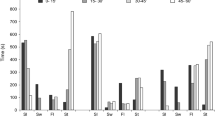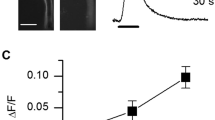We studied the effect of moderate heat stress (30oC) and muscarinic cholinergic receptor agonists arecoline and pilocarpine on sensitivity of the behavior of the nematode Caenorhabditis elegans of N2 line to the action of the agonist of nicotinic cholinergic receptor agonist levamisole. Heat stress and muscarinic cholinergic receptor agonists increased the sensitivity of swimming induced by mechanical stimulation to levamisole (32-64 μM), which manifested in dyscoordination of locomotor muscles during swimming and complete loss of ability to swim. Combined exposure to heat stress and muscarinic cholinergic receptor agonists revealed their synergism in the influence on sensitivity of swimming behavior to levamisole: heating to 30oC potentiated the effect of arecoline and arecoline potentiated the effect of heat stress. It is assumed, that the effect of heat stress on the sensitivity of nicotinic receptors is mediated by its effect on muscarinic receptors.
Similar content being viewed by others
References
Albuquerque EX, Pereira EF, Alkondon M, Rogers SW. Mammalian nicotinic acetylcholine receptors: from structure to function. Physiol. Rev. 2009;89(1):73-120.
Anderson GL, Cole RD, Williams PL. Assessing behavioral toxicity with Caenorhabditis elegans. Environ. Toxicol. Chem. 2004; 23(5):1235-1240.
Chan JP, Staab TA, Wang H, Mazzasette C, Butte Z, Sieburth D. Extrasynaptic muscarinic acetylcholine receptors on neuronal cell bodies regulate presynaptic function in Caenorhabditis elegans. J. Neurosci. 2013;33(35):14,146-14,159.
Dittman JS, Kaplan JM. Behavioral impact of neurotransmitter- activated G-protein-coupled receptors: muscarinic and GABAB receptors regulate Caenorhabditis elegans locomotion. J. Neurosci. 2008;28(28):7104-7112.
Gainutdinov MK, Belova EB, Kalinnikova TB, Kolsanova RR, Shagidullin RR. Sensitization of nicotinic acetylcholine receptors in soil nematode Caenorhabditis elegans through activation of muscarinic receptors by arecoline. J. Evol. Biochem. Physiol. 2015;51(4):349-351.
Ghosh R, Mohammadi A, Kruglyak L, Ryu WS. Multiparameter behavioral profiling reveals distinct thermal response regimes in Caenorhabditis elegans. BMC Biol. 2012;10:85. doi:https://doi.org/10.1186/1741-7007-10-85.
Glauser DA. How and why Caenorhabditis elegans uses distinct escape and avoidance regimes to minimize exposure to noxious heat. Worm. 2013;2:e27285. doi:https://doi.org/10.4161/worm.27285.
Jospin M, Qi YB, Stawicki TM, Boulin T, Schuske KR, Horvitz HR, Bessereau JL, Jorgensen EM, Jin Y. A neuronal acetylcholine receptor regulates the balance of muscle excitation and inhibition in Caenorhabditis elegans. PLoS Biol. 2009;7(12):e1000265. doi:https://doi.org/10.1371/journal.pbio.1000265.
Kalinnikova TB, Kolsanova RR, Belova EB, Shagidullin RR, Gainutdinov MK. Opposite effects of moderate heat stress and hyperthermia on cholinergic system of soil nematodes Caenorhabditis elegans and Caenorhabditis briggsae. J. Therm. Biol. 2016;62(Pt A):37-49.
Pereira L, Kratsios P, Serrano-Saiz E, Sheftel H, Mayo AE, Hall DH, White JG, LeBoeuf B, Garcia LR, Alon U, Hobert O. A cellular and regulatory map of the cholinergic nervous system of C. elegans. eLife. 2015;4. pii: e12432. doi:https://doi.org/10.7554/eLife.12432.
Satelle DB. Invertebrate nicotinic acetylcholine receptors — targets for chemicals and drugs important in agriculture, veterinary medicine and human health. J. Pestic. Sci. 2009;34:233-240. doi:https://doi.org/10.1584/jpestics.r09-02.
Steger KA, Avery L. The GAR-3 muscarinic receptor cooperates with calcium signals to regulate muscle contraction in the Caenorhabditis elegans pharynx. Genetics. 2004;167(2):633-643.
Tissenbaum HA, Hawdon J, Perregaux M, Hotez P, Guarente L, Ruvkun G. A common muscarinic pathway for diapause recovery in the distantly related nematode species Caenorhabditis elegans and Ancylostoma caninum. Proc. Natl Acad. Sci. USA. 2000;97(1):460-465.
Author information
Authors and Affiliations
Corresponding author
Additional information
Translated from Byulleten’ Eksperimental’noi Biologii i Meditsiny, Vol. 164, No. 8, pp. 169-172, August, 2017
Rights and permissions
About this article
Cite this article
Kalinnikova, T.B., Yakhina, A.F., Egorova, A.V. et al. Heat Stress and Agonists of Muscarinic Cholinergic Receptors Modulate Sensitivity of Nicotinic Cholinergic Receptors in Soil Nematode Caenorhabditis elegans . Bull Exp Biol Med 164, 144–147 (2017). https://doi.org/10.1007/s10517-017-3944-2
Received:
Published:
Issue Date:
DOI: https://doi.org/10.1007/s10517-017-3944-2




